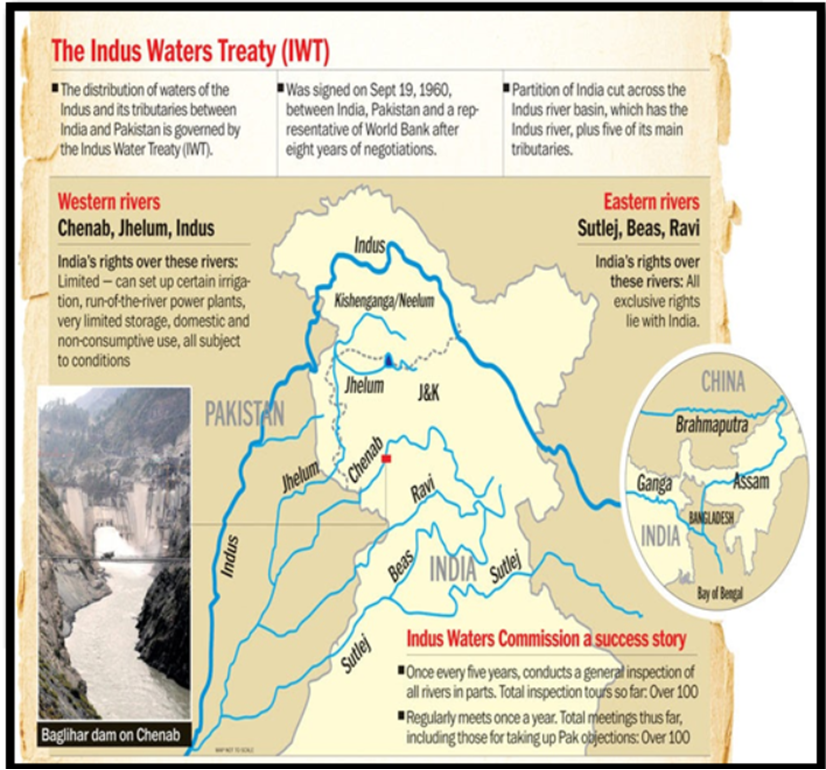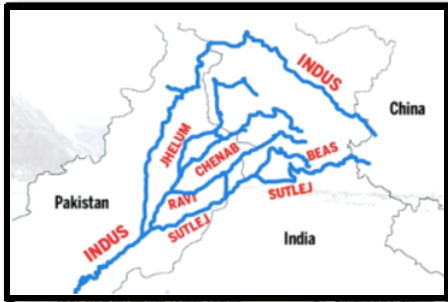A BEND IN THE RIVER- INDUS WATERS TREATY
SYLLABUS:
GS 2:
- Bilateral, regional and global groupings and agreements involving India and/or affecting India’s interests.
Focus:
- India called for amendments to the agreement last year due to its dissatisfaction with the dispute resolution process.
Source: DICS
Introduction to the Indus Waters Treaty (IWT)
- Historical Background: The 1960 Indus Waters Treaty (IWT) is a significant transboundary water-sharing agreement between India and Pakistan.
- Ongoing Disagreements: Despite its historical importance, persistent disagreements continue to plague the treaty’s implementation.
- India’s Call for Amendments: In an unprecedented move, India requested amendments to the IWT last year due to dissatisfaction with the dispute resolution process.
- Pakistan’s Response: Pakistan sought arbitration at The Hague over India’s hydroelectric projects, bypassing treaty-compliant proceedings.
- Climate Change Impacts: Changing environmental realities, such as climate change, underscore the need to revisit and amend the treaty.
| Key provisions of the Indus Waters Treaty
Water Sharing Provisions
Administrative provisions
Dispute resolution mechanism
Annulment provisions
|
Impacts of Climate Change on the Indus Basin
- NASA’s Findings: In 2015, NASA ranked the Indus basin as the world’s second most over-stressed aquifer.
- Glacial Contributions: Approximately 31% of the net basin flow originates from climate-impacted glaciers and snow melts.
- Seasonal Variability: Climate change leads to more volatile and seasonal mean annual flows.
- Unpredictable Monsoons: Erratic monsoon patterns contribute to the variability of flow volume.
- Water Quality Concerns: Deteriorating water quality poses threats to food security, human health, and biodiversity.
Economic and Agricultural Significance
- Central Role in Economies: The Indus basin is vital to the economies of both India and Pakistan.
- Pakistan’s Dependency: Over 90% of Pakistan’s agricultural output depends on the Indus.
- Population Growth: Increasing population and consumption intensify water demand.
- Nutritional Security: The deteriorating water quality threatens food and nutritional security.
- Infrastructure Disputes: Contentions often revolve around the perceived impacts of infrastructure development on downstream flows.
Political and Trust Issues
- Trust Deficit: A significant trust deficit exists between India and Pakistan, complicating cooperation.
- Accusations of “Water Terrorism”: Pakistan has accused India of “water terrorism” over projects like the Shahpurkandi barrage.
- Legal Permissibility: Projects like the Shahpurkandi barrage are legally permitted within the IWT framework.
- Provincial Tensions in Pakistan: Inter-provincial tensions within Pakistan also affect water governance.
- Need for a Cohesive Approach: It is essential to view the Indus basin as a cohesive geographical unit rather than through an insular, partitioned approach.
Integrating Ecological Perspectives
- Adoption of Environmental Flows (EF): It is crucial to institutionalize the adoption, allocation, and implementation of Environmental Flows within the IWT.
- Brisbane Declaration: EFs refer to the quantity and timing of freshwater flows necessary to sustain aquatic ecosystems.
- UN Watercourses Convention: Harmonizing EFs with the principles of equitable and reasonable use, and the duty to prevent significant transboundary harm is essential.
- Berlin Rules on Water Resources: The 2004 Berlin Rules emphasize minimizing environmental harm and maintaining ecological flows in transboundary rivers.
- Permanent Court of Arbitration: The 2013 ruling on India’s Kishanganga project highlights the obligation to release environmental flows downstream, setting a precedent for EFs in transboundary basins.
Enhancing Data Sharing and Collaboration
- Real-Time Data Sharing: Developing mechanisms for real-time data sharing between riparian states is crucial.
- Evaluation of Water Quality: Regular evaluation of water quality and changing flow magnitudes in numeric terms is necessary.
- Legally Binding Framework: A World Bank-supervised data-sharing framework within the IWT would ensure accountability.
- Climate Change as a Common Vulnerability: Recognizing climate change as a shared threat could foster better cooperation.
- Holistic Basin Management: Shifting focus to holistic basin management could re-establish the IWT as a positive example of Indo-Pak relations.
About Indus River
|
Source:The Hindu
Mains Practice Question:
Discuss the significance of the 1960 Indus Waters Treaty (IWT) in the context of India-Pakistan relations. Critically analyze the challenges posed by climate change, population growth, and infrastructure development on the treaty’s implementation. Suggest measures to enhance cooperation and ensure sustainable water management in the Indus basin.
Associated Articles:
https://universalinstitutions.com/inspection-of-power-projects-under-indus-water-treaty/
https://universalinstitutions.com/cross-the-boulders-in-the-indus-waters-treaty/





